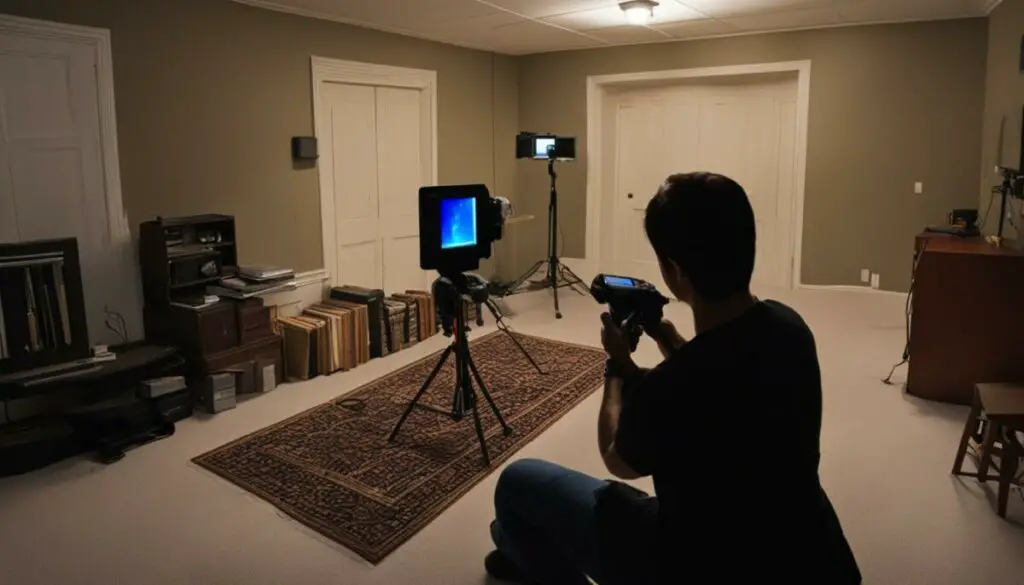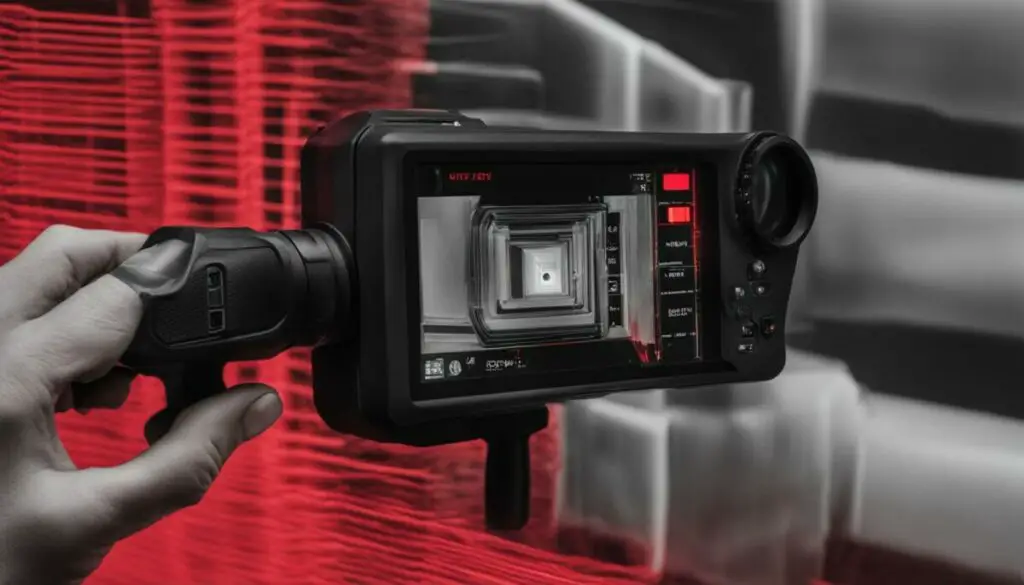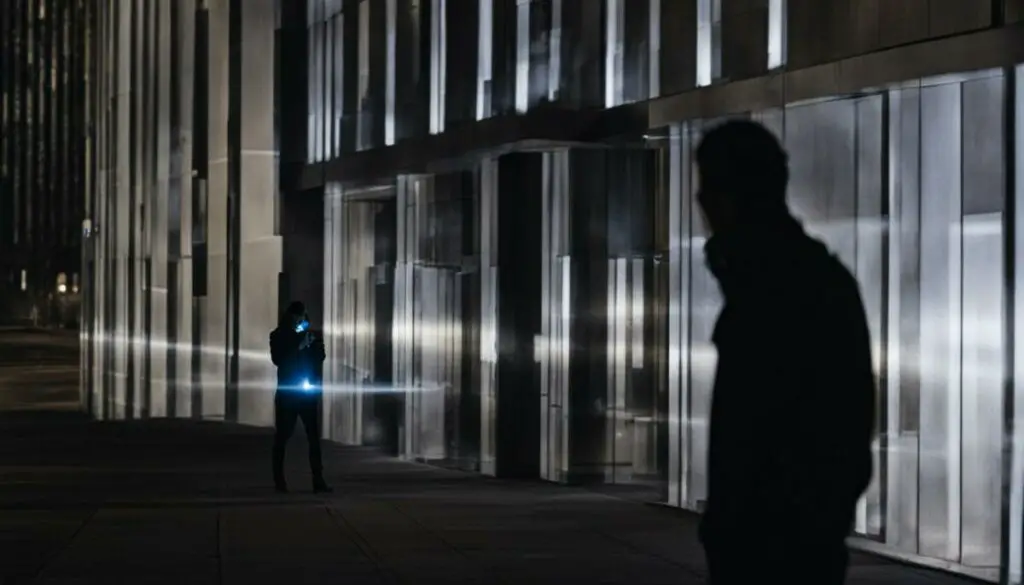Last Updated on 6 months by Francis
Infrared cameras are widely used in surveillance to monitor and capture images in low light or no light conditions. Although they serve an important purpose, they can also be used for illicit activities and pose a threat to our privacy. It’s essential to identify hidden infrared cameras to ensure our safety and security.
In this section, we will explore various methods and techniques that can be used to detect infrared cameras. We’ll provide step-by-step instructions and valuable tips to ensure you can easily identify hidden infrared cameras.
Contents
Key Takeaways:
- Knowing how to detect infrared cameras is crucial to protect your privacy and security.
- There are several techniques for identifying hidden infrared cameras, including visual inspection, specialized detection devices, testing for infrared radiation, smartphone apps, and checking for reflections and glare.
- Disrupting infrared camera signals is an additional layer of protection.
- Stay vigilant and follow best practices for detecting infrared cameras to maintain surveillance safety.
Understanding Infrared Cameras and Their Functionality

Infrared cameras are devices that capture thermal radiation, which is invisible to the human eye, and convert it into a visible image. They are commonly used in various industries, including surveillance, firefighting, and medicine. Infrared cameras can detect and highlight temperature differences within a specific area, making them useful in detecting hidden objects, including people, animals, and objects.
To understand how to detect hidden infrared cameras, it’s critical to be aware of the different types of infrared cameras and their functionality. Here are the most common types:
| Type of Infrared Camera | Functionality |
|---|---|
| Thermal Imaging | Captures heat signatures and displays them as a color-coded image, with warmer regions as brighter colors and cooler regions as darker colors. |
| Near Infrared | Used in various applications, including remote sensing and night-vision illumination. |
| Far Infrared | Used in astronomy and remote sensing, where detection of long-wavelength radiation is critical. |
To detect hidden infrared cameras, it’s important to understand that they can be hidden or disguised in various ways, including:
- Concealed in everyday objects such as clocks, smoke detectors, and light fixtures.
- Mounted inside walls or ceilings.
- Integrated into other devices, such as televisions and speakers.
Knowing the different types of infrared cameras and their potential hiding spots can help in identifying and detecting them.
Visual Inspection Techniques for Infrared Camera Detection

Visual inspection techniques are one of the most straightforward ways of detecting infrared cameras. Here are some tips to help you identify hidden infrared cameras:
- Physical Characteristics: Infrared cameras are usually small and can be concealed in everyday objects such as smoke detectors, light fixtures, and even pens. When scanning a room, look out for any unusual or out-of-place objects that could potentially house an infrared camera.
- Signs of Tampering: If you suspect that an object may contain an infrared camera, look for signs of tampering. For example, if a smoke detector appears to have been reassembled recently, it could be an indication that someone has placed a camera inside it.
- LED Lights: Infrared cameras have LED lights that may be visible in the dark. Check for any unexplained or unusual lights in the room, especially near the ceiling.
If you’re struggling to identify infrared cameras, consider using a flashlight to help you locate any LED lights. Shine the flashlight around the room and look for any reflections or glints that may indicate the presence of an infrared camera.
It’s important to note that visual inspection techniques may not always be foolproof. If you suspect that there may be hidden infrared cameras in the room, it’s always a good idea to use additional detection methods for added security.
Using Infrared Camera Detection Devices

Specialized devices are available that can help in detecting infrared cameras. These devices work by detecting the thermal energy radiated by the camera and alerting the user of its presence. Below are some of the most common types of infrared camera detection devices:
| Type of Detection Device | Description |
|---|---|
| Thermal Imaging Cameras | These cameras use infrared sensors to detect the heat emitted by objects, including infrared cameras. They produce live images of heat signatures, making it easy to identify the location of hidden cameras. |
| Infrared Camera Detectors | These devices emit an infrared light that is reflected by the camera lens, allowing the detector to locate the camera. They can also detect wireless signals emitted by cameras. |
| Signal Detectors | These devices can detect electromagnetic signals emitted by wireless cameras, making them useful for detecting hidden cameras that may be transmitting data wirelessly. |
When using infrared camera detection devices, it’s important to follow the manufacturer’s instructions carefully for optimal results. Keep in mind that these devices may not detect all types of infrared cameras, so it’s important to use them in combination with other detection techniques.
Tip: Before purchasing an infrared camera detection device, be sure to read reviews and compare features to ensure that you’re selecting the best device for your needs.
Testing for Infrared Radiation

One of the most effective methods for uncovering hidden infrared cameras is by testing for infrared radiation. Infrared cameras emit radiation in the infrared spectrum, which can be detected using specialized tools. The following steps outline how to test for infrared radiation:
- Turn off all lights and close all blinds or curtains to ensure no external light sources are present.
- Take your infrared camera detection device and scan the room, starting with the areas where a hidden camera is most likely to be placed, such as corners and places with a clear line of sight.
- Pay attention to any spots on the device’s screen that appear to glow or emit radiation. These spots could indicate the presence of an infrared camera.
- If you spot infrared radiation, move closer to the source to confirm its location. You can also use a directional antenna to locate the source more accurately.
Keep in mind that some electronic devices, such as remote controls and computer screens, may emit a small amount of infrared radiation and can produce false positives. Therefore, it’s important to be thorough in your inspection and confirm any suspicious readings with additional testing.
Avoiding False Positives
To ensure accurate testing and avoid false positives, it’s important to use an infrared camera detection device with a high-quality sensor and to follow the manufacturer’s instructions carefully. Additionally, it’s important to test your device in a controlled environment to ensure its accuracy and calibrate it regularly.
You can also use a reference source, such as a known infrared emitter, to confirm your device’s sensitivity and to verify any suspicious readings. This step will also help you better understand how your device works and how it detects infrared radiation.
By using the proper tools and techniques for testing infrared radiation, you can uncover hidden infrared cameras and safeguard your privacy and security.
Utilizing Smartphone Apps for Infrared Camera Detection

Smartphones have become an essential tool in our daily lives. Did you know that you can use your smartphone to detect hidden infrared cameras? There are several apps available for both iOS and Android devices that can help you find infrared cameras easily and quickly.
The first step is to download an infrared camera detection app from the app store. One popular app is the Hidden Camera Detector app, available for free on both iOS and Android. This app uses your smartphone’s camera and flash to detect hidden cameras by reflecting light off the lens of the camera.
Another popular app is the Glint Finder app, which uses your smartphone’s camera and flash to detect the reflection of infrared cameras. This app is available for free on Android devices.
| App Name | Platform | Price | Features |
|---|---|---|---|
| Hidden Camera Detector | iOS/Android | Free | Uses camera and flash to detect hidden cameras |
| Glint Finder | Android | Free | Uses camera and flash to detect infrared cameras by reflection |
Once you have downloaded the app, using it is simple. Point your smartphone at the suspected area and scan the room slowly. The app will alert you if it detects any hidden infrared cameras.
Keep in mind that these smartphone apps are not foolproof and may not detect all types of hidden infrared cameras. Therefore, it’s essential to use other detection methods, such as visual inspection and specialized infrared camera detection devices, in conjunction with these apps.
By utilizing smartphone apps for infrared camera detection, you can add another layer of protection to your surveillance safety. Download an infrared camera detection app today and start detecting hidden infrared cameras easily and quickly.
Checking for Reflections and Glare

Reflections and glare can frequently give away the presence of infrared cameras. You can identify the cameras by looking for reflections of their infrared LEDs in shiny or glossy surfaces such as mirrors, windows, or metal surfaces.
Here’s how you can detect infrared cameras using reflections and glare:
- First, look for reflective surfaces in the room or area you’re inspecting.
- Then, shine a flashlight or any bright light towards the surface.
- Next, scan the reflective surface for any unusual bright spots or dots that may indicate the presence of an infrared camera.
- Additionally, you can try tilting the reflective surface to check if the bright spots move or change position, suggesting that it’s a reflection of an infrared camera.
It’s essential to inspect all reflective surfaces in the area you’re checking, including any glass, metal, or other shiny surfaces.
If you notice any suspicious reflections or glare, it’s advisable to investigate further using other detection methods, such as radiation tests or infrared camera detection devices.
Remember that reflections and glare may not always be apparent or easily detectable, especially if the camera is concealed or disguised cleverly.
Using reflection and glare checking in combination with other techniques can significantly increase the chances of identifying hidden infrared cameras for surveillance safety.
Disrupting Infrared Camera Signals

As an additional layer of protection against infrared cameras, you can disrupt their signals, making it difficult for them to capture images. Here are some methods to consider:
- Use an Infrared LED Light: Infrared LED lights emit a powerful light that disrupts the camera’s infrared sensor. By shining this light directly at the camera, you can effectively blind it and prevent it from capturing any images.
- Use Infrared Laser Beams: Infrared laser beams can also be used to disrupt camera signals. By directing the beam at the camera lens, you can obscure the image and prevent it from being captured.
- Use Infrared Jammer: An infrared jammer is a device that emits infrared radiation at a higher frequency than the camera. This disrupts the camera’s signal and blocks its ability to capture any images.
- Use Smoke or Fog: Smoke or fog can be used to obstruct the camera’s view. By producing a thick cloud of smoke or fog, you can obscure the camera’s lens and prevent it from capturing images.
Keep in mind that these methods may not always be practical or legal, so be sure to consider the potential consequences before attempting any of them. Additionally, disrupting camera signals may not be effective against all types of infrared cameras, especially those with advanced technology.
“Disrupting infrared camera signals can be an effective way to prevent them from capturing images.”
Additional Tips and Precautions for Infrared Camera Detection
When it comes to identifying and finding hidden infrared cameras, there are several tips and precautions to keep in mind. These tips can help you ensure that you are taking all necessary steps to detect potential threats.
Avoid Obvious Places
First and foremost, it’s important to think about the locations where infrared cameras may be concealed. Try to avoid obvious places such as smoke detectors, light fixtures, and other areas where cameras may be easily visible.
Check Power Outlets
Another tip is to check power outlets for any signs of tampering or suspicious activity. Infrared cameras require power, so if there is an outlet in the vicinity, be sure to examine it closely.
Use Multiple Detection Techniques
While each detection technique has its own advantages, it’s best to use a combination of methods for optimal results. By using multiple techniques, you can increase the likelihood of finding hidden infrared cameras.
Stay Up-to-Date on Technology
As technology evolves, so do the methods for hiding and detecting infrared cameras. It’s important to stay up-to-date on the latest techniques and technologies in order to stay ahead of potential threats.
Exercise Caution in Public Spaces
Finally, it’s important to exercise caution in public spaces where surveillance is common. Avoid discussing sensitive information or engaging in activities that may draw unwanted attention.
By following these additional tips and precautions, you can ensure that you are taking the necessary steps to identify and find hidden infrared cameras. Remember to stay vigilant and always prioritize your safety and security.
Conclusion
By following the methods and techniques outlined in this article, you can now easily and quickly detect hidden infrared cameras. Remember to employ a combination of visual inspection techniques, specialized detection devices, radiation tests, smartphone apps, reflection checking, and signal disruption methods for effective detection and protection.
Stay Vigilant
It’s important to be vigilant and maintain surveillance safety in any environment. Always be aware of your surroundings and stay alert for any signs of hidden cameras. By following the tips and precautions outlined in this article, you can ensure your privacy and security at all times.
Practice Makes Perfect
The more you practice infrared camera detection techniques, the easier it will become. Don’t be afraid to test out different methods and devices until you find the ones that work best for you. With time and practice, you’ll be able to easily identify hidden cameras in any setting.
Protect Your Privacy
Whether you’re at home, in the workplace, or out in public, it’s important to protect your privacy. By detecting hidden infrared cameras, you can ensure that your personal information and actions are not being recorded without your consent. Stay vigilant, stay safe, and always be aware of your surroundings.
FAQ
How can I detect infrared cameras easily and quickly?
There are several methods you can use to detect infrared cameras, including visual inspection, using specialized detection devices, testing for infrared radiation, utilizing smartphone apps, checking for reflections and glare, and disrupting infrared camera signals. By following these techniques and staying vigilant, you can easily and quickly detect infrared cameras.
What are infrared cameras and how can they be concealed?
Infrared cameras are devices that capture images using infrared radiation. They can be hidden or disguised in various ways, such as being embedded in objects, concealed behind mirrors, or disguised as everyday items. Understanding how they may be concealed is important in effectively detecting them.
What are some visual inspection techniques for infrared camera detection?
Visual inspection is a great way to identify infrared cameras. Look for physical characteristics such as lens reflections, unusual wires or cables, or small apertures. Additionally, pay attention to signs such as extra heat sources or LED indicators that may indicate the presence of an infrared camera.
Are there any special devices for detecting infrared cameras?
Yes, there are specialized detection devices available in the market that can help uncover hidden infrared cameras. These devices use various technologies such as thermal imaging or radio frequency scanning to detect the presence of infrared cameras.
You can use specific tools that can detect infrared radiation emitted by infrared cameras. These tools can range from spot infrared thermometers to thermal imaging cameras. By scanning the area for abnormal heat signatures, you can often uncover hidden infrared cameras.
Can smartphone apps be used for infrared camera detection?
Yes, there are smartphone apps available that can aid in infrared camera detection. These apps utilize the smartphone’s camera and sensors to identify infrared sources. However, they may not be as accurate as specialized detection devices.
How can reflections and glare help in detecting infrared cameras?
Reflections and glare can give away the presence of infrared cameras. Look for unusual reflections or glows in mirrors or glass surfaces, especially in areas where a camera may be hidden. Pay attention to any sources of light that seem out of place or emit an unusual color.
Are there any methods to disrupt infrared camera signals?
Yes, there are techniques you can employ to disrupt infrared camera signals, making it difficult for them to capture images. These may include using reflective materials, applying infrared-blocking window films, or using infrared light sources to flood the area with non-specific infrared radiation.
Are there any additional tips for infrared camera detection?
Some additional tips include regularly conducting inspections, being aware of your surroundings, understanding the capabilities of infrared cameras, and seeking professional help if needed. It’s also important to keep your privacy and security in mind at all times.








